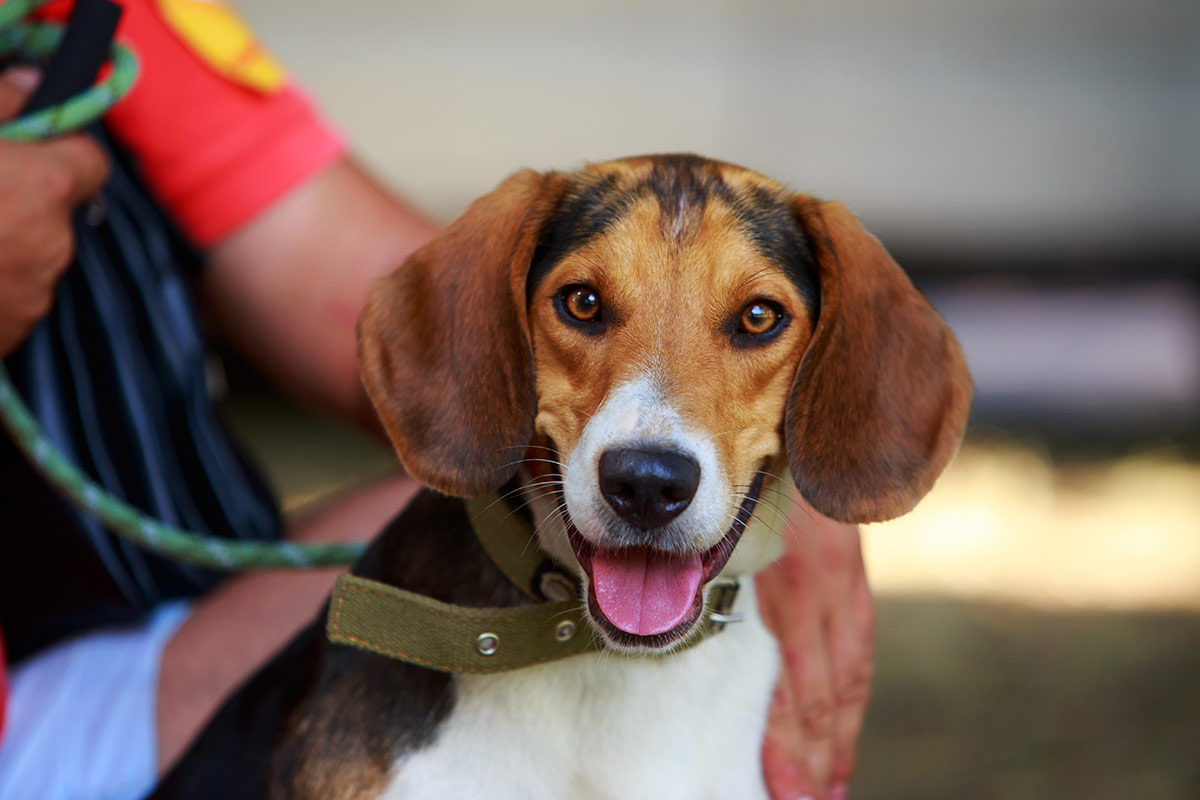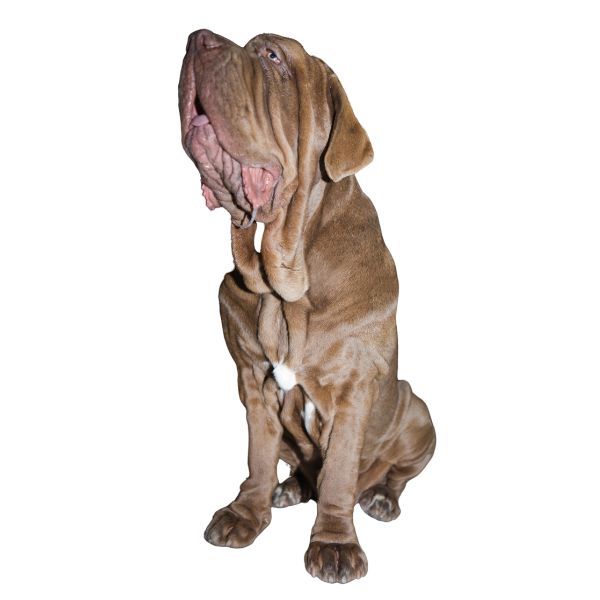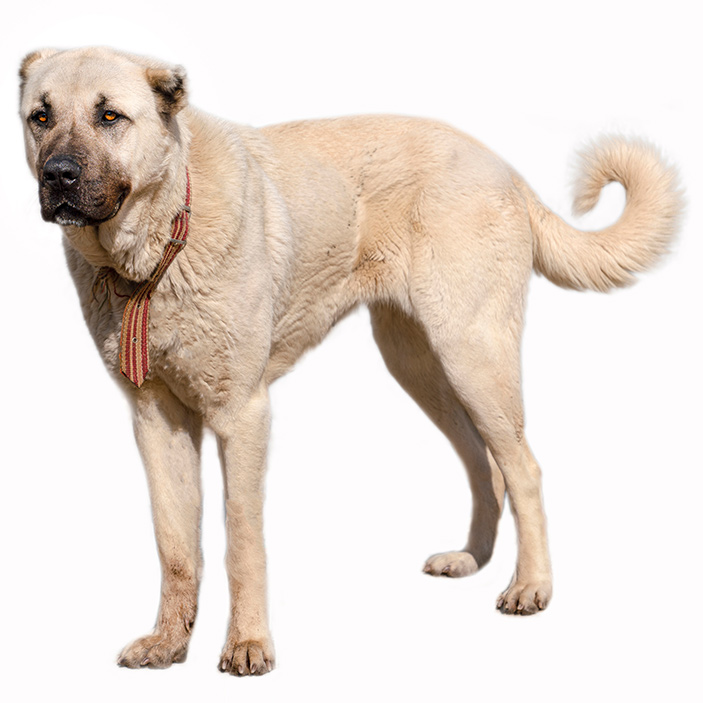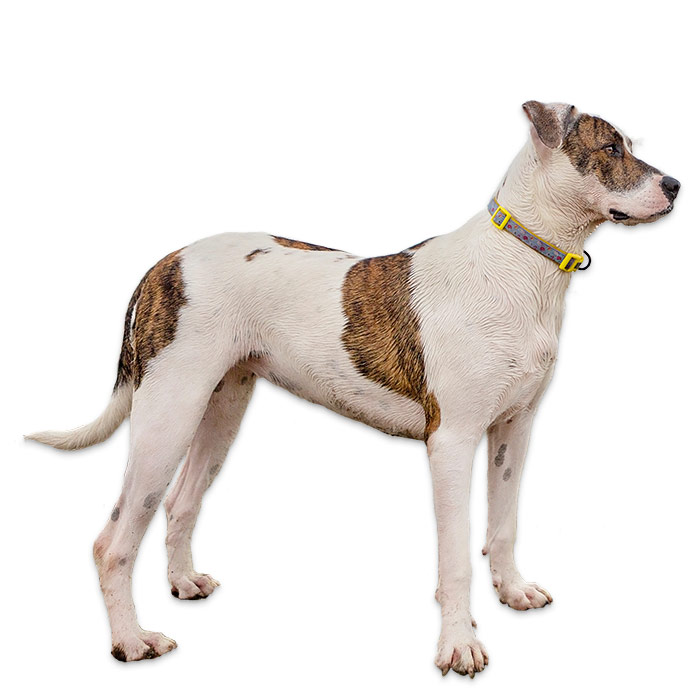American Foxhound
Easy-going, good-natured, independent
This breed has a medium probability of having health issues in its lifetime, hence it is one of the more affordable breeds to insure.

Is this breed right for you?
Try our breed selector quiz to find out your best matching breed!
Insuring a American Foxhound?
Get our award-winning Nose-to-Tail Cover with up to $30k annual benefit limit, up to 90% of eligible vet bills back, and no sub-limits.
Get a quick quoteBreed Overview
The American Foxhound is, as its name suggests, a hunting dog bred in the USA to hunt foxes and other game. A scenting pack hound, she has tremendous hunting instincts, a keen sense of smell and great energy to run effortlessly for many hours on the chase. She is known for her speed, endurance and work ethic. When hunting, she works with a pack of likeminded foxhounds who track quarry along with hunters, who usually follow on horseback.
The American Foxhound’s sleek, rangy body is well balanced, powerful and clean cut. With longer, leaner and more finely boned legs than her cousin, the English Foxhound, her loin (back end) is slightly arched, allowing her a greater speed and agility over rough terrain. At maturity, the breed reaches a height of 58 to 64 cm and a weight of 27 to 32 kg.
Her face is characterised by her large, soft brown eyes, set well apart, and her expression is described as gentle and pleading. She has a short, hard coat lying close to her body that is usually a tricolour of black, white and tan. The coat’s hard texture protects her from the underbrush she courses through while on the hunt and is easy to take care of, requiring merely a short, once-a-week grooming session and bathing only when absolutely necessary.
Although grooming her is easy, taking care of some of an American Foxhound’s other needs can be much more challenging! Bred specifically to spend long hours chasing after prey, she needs LOTS of daily exercise, or she can quickly become depressed or destructive (or both). She really does require a very active owner, such as a long-distance runner or hiker, a frequent hunter, or a dog sport enthusiast. Additionally, she has a single-minded prey drive that needs careful management – and to be kept on the leash when out and about – as well as a large, securely fenced-in yard in which to run loose.
The American Foxhound is definitely not suited to apartment life or even to urban environments. With voice generously described as ‘melodious’ when on the trail, her loud baying and bawling can be extremely disturbing to neighbours within earshot. She is most suited to country living, where her activity needs can be more easily met, and her daily concerts won’t disturb neighbours. Despite this, she is not an outdoor dog; rather, she loves being indoors with her human companions or hanging out with other dogs – after all, she is very much a pack animal.
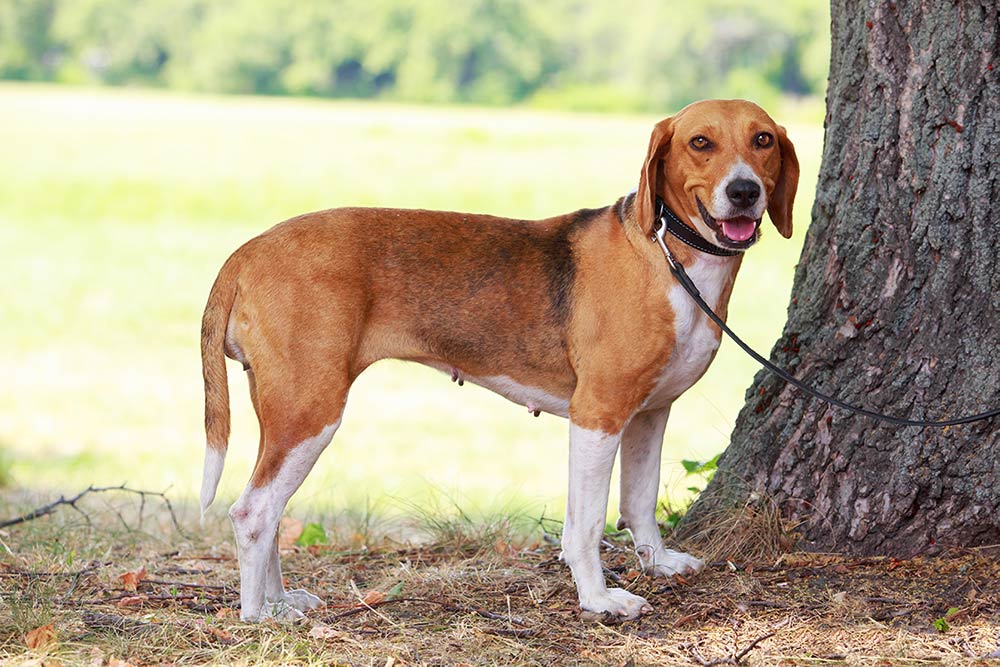
Personality and Temperament
The American Foxhound is described as independent and stubborn but also friendly, easy-going, sweet-tempered and good-natured. She gets on well with kids, dogs and even cats that she has been raised with. In fact, these dogs are known to be great with children and make good playmates for them. They genuinely love kids, are very tolerant towards them and they’ve been known to help toddlers take their first steps by allowing them to hold on to their tails!
This raises the question, why are American Foxhounds so unpopular as pets, placed 186th of 197 breeds on the American Kennel Club’s Breed Popularity ranking? After all, they are well-mannered, kind, and loyal, and can make great family companions. There are a number of reasons…
Firstly, the breed was developed as a working dog and traditionally was not kept as a house pet, but a member of a hunting pack on an estate. This has not
changed considerably with the passage of time, although today, most American Foxhounds are owned by foxhunting clubs. Secondly, the American Foxhound requires a significant amount of exercise in order to be happy and healthy – way more than what the average urban family can provide. These dogs will develop unwanted behaviours if not given enough exercise.
Furthermore, despite their gentle natures, American Foxhounds have a tendency to be destructive. As well as insufficient exercise, a trigger for destructive behaviour appears to be anxiety when their owner goes away. To alleviate feelings of separation anxiety, they will start to chew, eat and destroy things in the home. They’ll also whine to get their owners’ attention when they leave the room, and their persistent baying and howling can carry for miles, to the annoyance of even the most accommodating of neighbours.
Because of their prey-driven, independent and stubborn nature, owners will need patience and persistence when training them. Obedience classes are recommended even for experienced owners. As scent hounds, it may never be safe to walk or exercise them off-leash, because their noses can lead them into trouble; once on a scent, he can be extremely difficult to call back. In truth, training and housebreaking can be very challenging for novice owners. Sternness and firmness are necessary for these dogs to effectively follow training commands, or they will get their own ideas.
Finally, American foxhounds can be reserved and protective around strangers and may occasionally be aggressive towards them. She shouldn’t be left unsupervised around cats and other small creatures that she hasn’t been raised with, as she may regard them as prey. As a pack animal, she enjoys the company of other dogs and is best suited to a home where she is not the only dog.
Common American Foxhound Diseases & Conditions
Symptoms, diagnosis and treatment
The American Foxhound is typically a healthy breed, with no major health concerns. Occasionally a blood disorder may be seen, as well as hip dysplasia. Ear infections are more likely to occur in long-eared breeds.
Hip Dysplasia: Hip dysplasia can arise with this type of dog, because of their long legs. This inherited condition occurs when the top of the thighbone doesn’t fit snugly into the socket of the hip joint. Some dogs experience pain and lameness in one or both rear legs, while others may not show any signs of discomfort. Arthritis can develop in the affected joint as the dog ages.
Blood disorders: Hereditary blood disorders can affect this breed, two of the more common conditions being thrombocytopathy and Pelger–Huët anomaly.
Thrombocytopathy covers a range of blood disorders characterised by dysfunctional platelets (thrombocytes) in the blood. They can develop from increased platelet function (resulting in thrombosis) or decreased function (resulting in haemorrhage).
The Pelger–Huët Anomaly (PHA) impacts the white blood cells, causing abnormalities called granulocytes. Though the condition is benign, it may be mistaken for infection or early stage leukemia.
Ear infections: American Foxhounds, like other long-eared breeds are prone to ear infections, which fortunately can be easily treated. An American Foxhound’s ears should be checked regularly to remove foreign matter and avoid a build-up of wax.
Not all conditions are covered by Pet Insurance. For details of Bow Wow Meow Pet Insurance cover, refer to the Product Disclosure Statement.
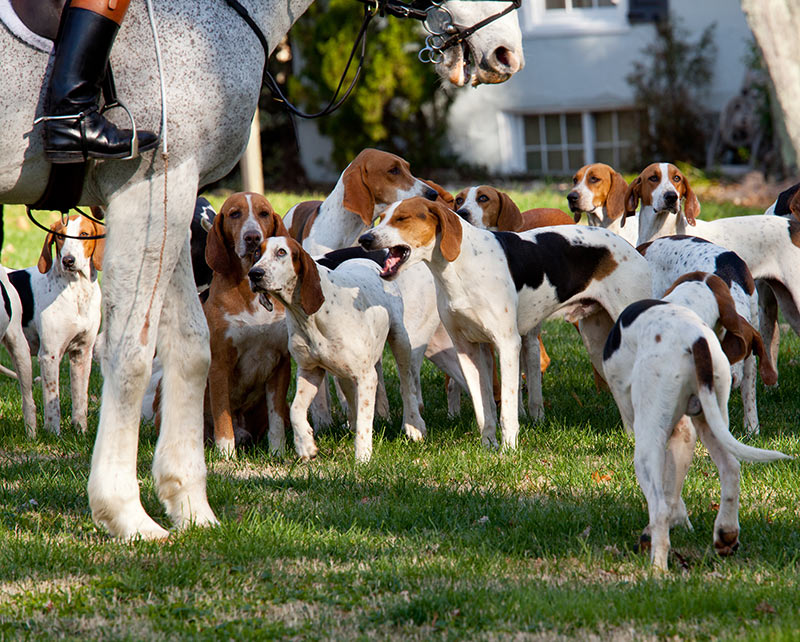
History
The American Foxhound was one of the first dog breeds – possibly even the first – to be developed in the USA. It originated from a line of dogs brought to the American colonies from England by Robert Brooke in 1650. Descendants of those hounds were bred with other European hounds to develop a dog that was taller, lighter, and faster to suit the terrain of their new home.
George Washington was known as a breeder and maintained a pack of foxhounds bred from British imports at his Mount Vernon estate in the southern state of Virginia. An avid foxhunter, he kept meticulous records of his breeding program and strived to improve the dogs by breeding them with French Foxhounds. Washington was creative with the names he gave to these “perfect foxhounds,” including Sweet Lips, Searcher, Tipsy, Tipler, and Drunkard! While he didn’t invent American Foxhounds single-handedly, Washington was a key player in the breed’s development.
In post-Colonial times, further refinements were made to the American Foxhound throughout the South until the breed was distinctly separate from its cousin the English Foxhound. Until the advent of the Civil War, foxhunting with hounds was the primary field sport of the American gentry.
Today, the American Foxhound is the state dog of Virginia. She is found most frequently on the Atlantic Seaboard and in the Southern United States, usually as a member of a pack owned by a foxhunting club. Nowadays, within the breed, there are four types of American Foxhound:
- Field-trial hounds, which have great speed and competitive spirit
- Fox-hunting hounds, which are known to work slowly, with a musical voice
- Trail hounds, which race or hunt following an artificial lure
- Pack hounds, which are used in large packs by hunters on horseback
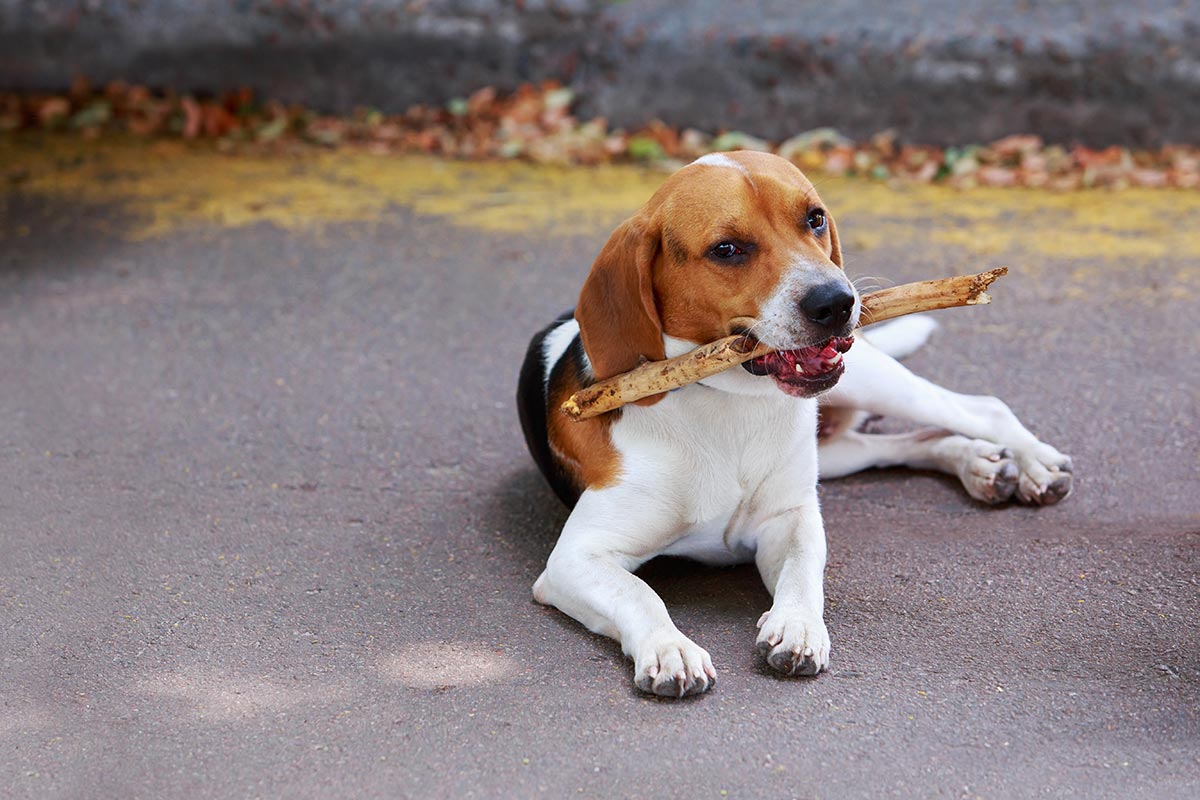
American Foxhound Facts!
- Along with eight other breeds, the American Foxhound was recognised by the American Kennel Club in 1886, shortly after that organisation’s establishment.
- The American Foxhound was bred to chase a fox, but not to kill it.
- She has always worked closely alongside horses.
- She is taller and more streamlined than the English Foxhound.
- Her tail has a very slight brush, meaning that it’s heavy with hair.
- The American Foxhound is the state dog of Virginia.
Free engraved pet ID tag on sign up3
Customer Satisfaction
21 day cooling off
Easy to use Pet Portal

GapOnly® in vet claims
FURTHER INFORMATION
American Kennel Club: https://www.akc.org/dog-breeds/american-foxhound/
American Kennel Club: https://www.akc.org/expert-advice/lifestyle/special-traits-american-foxhound/

